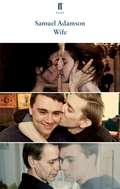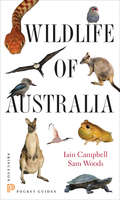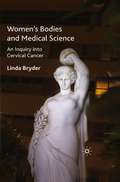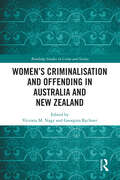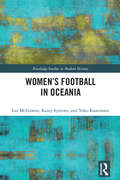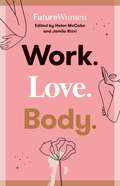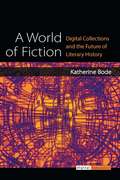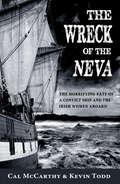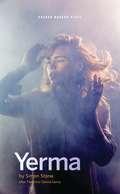- Table View
- List View
Wife
by Samuel Adamson- And your husband forgave you. But what did you do? Decided that forgiveness was offensive and walked out on your marriage. With nothing. Into nothing.- Into everything, I think.It's 1959. Robert leaves Ibsen's A Doll's House outraged by its attack on the sanctity of marriage; his wife Daisy dashes round to the stage door, in love with both Nora and the actress who plays her, thrilled by their promise of escape.Daisy is at the crossroads. Her moral compass tells her to go one way, society the other. What she chooses to do next will have consequences not just for her and Robert, but for four couples who come after them over ninety years.The truth is we have to give up parts of ourselves if we want to be with someone. And what if, before you know this, you run away from the wrong person?Samuel Adamson's Wife premiered at the Kiln Theatre, London, in May 2019.
Wildlife of Australia
by Iain Campbell Sam WoodsIdeal for the nature-loving traveler, Wildlife of Australia is a handy photographic pocket guide to the most widely seen birds, mammals, reptiles, amphibians, and habitats of Australia. The guide features more than 400 stunning color photographs, and coverage includes 350 birds, 70 mammals, 30 reptiles, and 16 frogs likely to be encountered in Australia's major tourist destinations. Accessible species accounts are useful for both general travelers and serious naturalists, and the invaluable habitat section describes the Australian bush and its specific wildlife. Animal species with similar features are placed on the same plates in order to aid identification. Wildlife of Australia is an indispensable and thorough resource for any nature enthusiast interested in this remarkable continent. Easy-to-use pocket guide More than 400 high-quality photographs Accessible text aids identification Habitat guide describes the Australian bush and its specific wildlife Coverage includes the 350 birds, 70 mammals, 30 reptiles, and 16 frogs most likely to be seen on a trip around Australia
Women's Bodies and Medical Science: An Inquiry into Cervical Cancer (Science, Technology and Medicine in Modern History)
by L. BryderAn analysis of a scandal involving a doctor accused of allowing a number of women to develop cervical cancer from carcinoma in situ as part of an experiment he had been conducting since the 1960s into conservative treatment of the disease, to more broadly explore dramatic changes in medical history in the second half of the twentieth century.
Women’s Criminalisation and Offending in Australia and New Zealand (Routledge Studies in Crime and Society)
by Victoria M. Nagy Georgina RychnerWomen’s Criminalisation and Offending in Australia and New Zealand offers new research and analysis of women’s offending and criminalisation in Australia and New Zealand from British settlement through to the late twentieth/early twenty-first centuries. Drawing attention to women as offenders as understood in a multitude of ways, this collection highlights how women have been involved with crime and criminal behaviour, their treatment inside and outside of courts and prisons, and how women’s deviation from societal norms have attracted negative attention throughout the decades. For Aboriginal and Māori women especially, the responses were harsher than what they could be for non-indigenous women. The chapters cover a broad range of transgressions that women have been actively involved with, including theft, drug and alcohol abuse and offences, organised crime, and homicide, as well as how women’s behaviour and their bodies have been criminalised and responded to by authorities. What this collection demonstrates is that women have often chosen to be involved with crime and criminality, while on other occasions their behaviour, innocent as it was, was not considered acceptable by contemporaries, resulting in confusion and misapprehension of women who refused to fit a mould. Women’s Criminalisation and Offending in Australia and New Zealand brings together historical and criminological methods, theories, and scholars to shed light on how Australia and New Zealand’s colonial, later state, and national governments have sought to understand, control, and punish women. This collection will be of interest and value to scholars, students, and everyone with an interest in criminology, history, law, sociology, Indigenous studies, and Australian and New Zealand studies.
Women’s Criminalisation and Offending in Australia and New Zealand (Routledge Studies in Crime and Society)
Women’s Criminalisation and Offending in Australia and New Zealand offers new research and analysis of women’s offending and criminalisation in Australia and New Zealand from British settlement through to the late twentieth/early twenty-first centuries. Drawing attention to women as offenders as understood in a multitude of ways, this collection highlights how women have been involved with crime and criminal behaviour, their treatment inside and outside of courts and prisons, and how women’s deviation from societal norms have attracted negative attention throughout the decades. For Aboriginal and Māori women especially, the responses were harsher than what they could be for non-indigenous women. The chapters cover a broad range of transgressions that women have been actively involved with, including theft, drug and alcohol abuse and offences, organised crime, and homicide, as well as how women’s behaviour and their bodies have been criminalised and responded to by authorities. What this collection demonstrates is that women have often chosen to be involved with crime and criminality, while on other occasions their behaviour, innocent as it was, was not considered acceptable by contemporaries, resulting in confusion and misapprehension of women who refused to fit a mould. Women’s Criminalisation and Offending in Australia and New Zealand brings together historical and criminological methods, theories, and scholars to shed light on how Australia and New Zealand’s colonial, later state, and national governments have sought to understand, control, and punish women. This collection will be of interest and value to scholars, students, and everyone with an interest in criminology, history, law, sociology, Indigenous studies, and Australian and New Zealand studies.
Women’s Football in Oceania (Routledge Studies in Modern History)
by Lee McGowan Kasey Symons Yoko KanemasuThis book presents the most comprehensive mapping and analysis of women’s football in Oceania and is the first to examine the game’s historical development alongside social, political and cultural issues, weaving origin stories with players’ day-to-day challenges. Alongside presentation of the contemporary state of play and its overarching narrative of women’s game in the region, the book highlights key issues, discusses established and emergent themes, examines relevant contexts, investigates the status of the game at local and national levels and lays foundations for further research. Its primary objective is to detail and illustrate the historical, social, and organisational development of the women’s game, including international tournaments, national competitions, and teams in an effort to amplify the efforts of the individuals that made or make a significant contribution to the game. It draws on extensive formal and informal discussion, realises insight, proposes the means and related fields of further investigation and generates new knowledge alongside the uncovering of old. Women’s Football in Oceania covers key events, actors and moments and fills a gap in research for scholars of sports history and women’s history.
Women’s Football in Oceania (Routledge Studies in Modern History)
by Lee McGowan Kasey Symons Yoko KanemasuThis book presents the most comprehensive mapping and analysis of women’s football in Oceania and is the first to examine the game’s historical development alongside social, political and cultural issues, weaving origin stories with players’ day-to-day challenges. Alongside presentation of the contemporary state of play and its overarching narrative of women’s game in the region, the book highlights key issues, discusses established and emergent themes, examines relevant contexts, investigates the status of the game at local and national levels and lays foundations for further research. Its primary objective is to detail and illustrate the historical, social, and organisational development of the women’s game, including international tournaments, national competitions, and teams in an effort to amplify the efforts of the individuals that made or make a significant contribution to the game. It draws on extensive formal and informal discussion, realises insight, proposes the means and related fields of further investigation and generates new knowledge alongside the uncovering of old. Women’s Football in Oceania covers key events, actors and moments and fills a gap in research for scholars of sports history and women’s history.
Work. Love. Body.: Future Women
by Jamila Rizvi Helen McCabeIn 2020, the lives of Australian women changed irrevocably. With insight, intelligence and empathy, Jane Gilmore, Santilla Chingaipe and Emily J. Brooks explore this through the lenses of work, love and body, and ask: Will the Australia of tomorrow be more equal than the one we were born into? Or will women and girls remain left behind?While our country was shrouded in smoke in the early months of 2020, Australian women went about their daily business. They worked, studied, cleaned, did school runs, made meals. And they postponed looking after themselves because life got in the way.Then, in March, Australians were told to lock down. For all the talk of equality, it was primarily women who held the health of our communities in their hands as they took on the essential jobs to care, to nurse and to teach, despite an invisible danger. One year later, women across the country would march on behalf of those who were not safe in workplaces and their own homes.Never before has change been thrust so abruptly on modern Australian women - 2020 impacted our working lives, relationships and our health and wellbeing. And as a growing number of women agitate for change, it is time to demand what women want. So where do we go from here?One thing is very clear: the future is now, and it is female.
A World of Fiction: Digital Collections and the Future of Literary History (Digital Humanities)
by Katherine BodeDuring the 19th century, throughout the Anglophone world, most fiction was first published in periodicals. In Australia, newspapers were not only the main source of periodical fiction, but the main source of fiction in general. Because of their importance as fiction publishers, and because they provided Australian readers with access to stories from around the world—from Britain, America and Australia, as well as Austria, Canada, France, Germany, New Zealand, Russia, South Africa, and beyond—Australian newspapers represent an important record of the transnational circulation and reception of fiction in this period. Investigating almost 10,000 works of fiction in the world’s largest collection of mass-digitized historical newspapers (the National Library of Australia’s Trove database), A World of Fiction reconceptualizes how fiction traveled globally, and was received and understood locally, in the 19th century. Katherine Bode’s innovative approach to the new digital collections that are transforming research in the humanities are a model of how digital tools can transform how we understand digital collections and interpret literatures in the past.
The Wreck of the Neva: The Horrifying Fate of a Convict Ship and the Women Aboard
by Cal McCarthy Kevin ToddThe 'Neva' sailed from Cork on 8 January 1835, destined for the prisons of Botany Bay. There were 240 people on board, most of them either female convicts or the wives of already deported convicts, and their children. On 13 May 1835 the ship hit a reef just north of King's Island in Australia and sank with the loss of 224 lives - one of the worst shipwrecks in maritime history. The authors have comprehensively researched sources in Ireland, Australia and the UK to reconstruct in fascinating detail the stories of these women. Most perished beneath the ocean waves, but for others the journey from their poverty stricken and criminal pasts continued towards hope of freedom and prosperity on the far side of the world. At a time when Australia is once again becoming a new home for a generation of migrating Irish, it is appropriate that the formative historical links between the two countries be remembered.
Yerma (Oberon Modern Plays)
by Federico García Lorca Simon Stone"Well we’ve got three floors right. Plenty of room… Room for a children’s bedroom. Room for two."London, the present day. A woman is driven to the unthinkable by her desperate desire to have a child.Written and directed by Simon Stone, this radical new version of Lorca’s tragedy of yearning and loss won universal critical acclaim when it premiered at the Young Vic in July 2016. Yerma triumphed at the 2017 Olivier Awards, with the production winning Best Revival, and Piper winning Best Actress. She also won the Evening Standard Natasha Richardson Award for Best Actress. Maureen Beattie, Brendan Cowell, John MacMillan and Charlotte Randle received unanimous praise for their performances.
